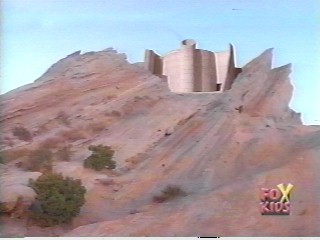l
I spent this past weekend in the southeastern Macedonian city of Strumica. It's home to about 35,000 people, predominantly Macedonian, but with large Turkish and Roma neighborhoods. It's a lovely little down nestled against a mountain, and is known for beautiful women and for a great nightlife. Naturally, I spent all my times climbing around old things instead.
My guides were Zoran Rujak, the chief archaeologist of the area, and his friend Atsev, who works for a local tourist agency. Zoran speaks excellent English, and looks like a young Jeff Daniels (think Arachnophobia, not Dumb and Dumber), and loves classic rock. There's really something special going on when two Macedonians start singing "The Night The Drove Old Dixie Down" as you barrel down a mountain in a Fiat.
Anyway, our first stop was a monastery off to the east of the city. The chapel there was built in 1080, but badly damaged by fires in 1913 and 1968. One of the remaining undamaged frescoes is of Jesus as a 12 year old, which is fairly unusual. I didn't take pictures because I was afraid my guide, Sister Nauma, would give me a dirty look. After we wandered around the monastery, Sister Nauma served us cake and a special homemade walnut rakija. This is probably the most delicious liquor I've ever tasted - it was like ingesting autumn. They soak green walnuts, cinnamon, sugar and cloves in the local brandy - delicious. I bought two bottles. Here's Sister Nauma speaking with Zoran on the left and Atsev on the right:

We then headed to rebuild Orthodox church with foundations dating from the 6th century AD. Oddly enough, it was connected to a bath complex, where I guess all the monks took bubble baths:

We then headed through the Roma neighborhood to yet another church, the Church of the Holy Fifteen Martyrs. The Fifteen Martyrs are the protectors of Strumica, and while I can't recall the exact story of these particular martyrs, I think they were Roman soldiers who refused to denounce their faith when
Julian the Apostate rolled in and tried to bring Jupiter and Mars back to the party.
There's a great story to this church, as well. The local people had always though that particular area holy, though no one remembered why; a shrine made from the hollowed trunk of a tree in the 19th century still stands there. In 1913, a Serbian officer decided to dig around the shrine and see what he could find. He discovered the foundations of a Late Antique chapel, buried it again, and built his own shrine on top of that. Modern excavations have uncovered a very elaborate cathedral complex that dates to even earlier periods. Here is the 1913 Serbian shrine, as seen from the excavation of the earliest cathedral:

We then took a frightening dirt-mountain track two miles into the mountains above Strumica to visit Zoran's current dig site, known as the Tsar's Towers. . .





















